Witcher 3 is a fantastic game, but it doesn’t hold your hand. That’s especially true in the early game.
Whether you’re a completely new player looking for essential tips or a veteran looking to optimize their playthrough after the next-gen update, our early game Witcher 3 guide will help.
We’ll cover general early-game tips, the best early skills, weapons, armor, builds, and more for the first 15 levels or so.
Table of Contents
General early game tips
For starters, here are some essential early-game tips:
- Use the bestiary to help you defeat difficult monsters
- Pick up the Quen active shield and delusion Axii skills
- Make money by selling everything you have to the right merchants (e.g. weapons to blacksmiths) and consider farming cowhides
- Pick up all the places of power you can to get extra skill points quickly
More on each point below. And if you’re completely new to the game, here’s an expanded list of Witcher 3 tips and tricks.
Bestiary
The Witcher 3 early game has plenty of tough enemies, especially if you’re new to the game. Thankfully, we have a useful Bestiary that lists all the creatures you’ve faced without necessarily having killed them.
Besides a detailed description of the monster, there’s a section showing its vulnerabilities, which includes items and specific signs.
Signs
It’s important to take advantage of two specific Sign skills in Witcher 3’s early game:
- Quen: Quen’s Active shield upgrade creates a protective bubble, absorbing damage and healing you simultaneously. It’s especially helpful on Death March difficulty, where damage is high and ways to heal are limited.
- Axii Delusion – The delusion upgrade (at least 2 points) for Axii is incredibly useful throughout every stage of Witcher 3. When you upgrade it, you not only earn additional experience every time you use it during dialogue but also open up new dialogue options, which can often prevent you from having to fight someone or pay gold.
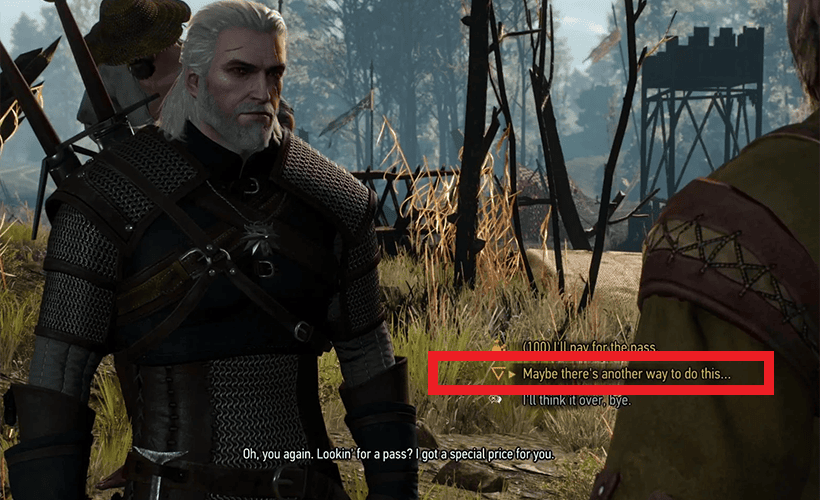
Making Money
Aside from completing quests and collecting loot, selling the runes and glyphs you’re not using is the most practical way to make money.
Another trick is to turn into a cow slayer. Their hides fetch a good price, especially when sold to specific merchants like Marquise Serenity at The Passiflora.
The best spot is Martin Feuille’s Farmstead to the east of Novigrad. Here, you can kill the cows (but you should leave the ones in the barn alive), loot their hides, meditate to respawn, rinse and repeat.
Check out our dedicated money-making guide for more tips.
Pro-tip: If you find seashells, don’t sell them. Dismantle them and sell the pearls for more money. Thanks to PaulSimonBarCarloson at Reddit for the idea.
Places of Power
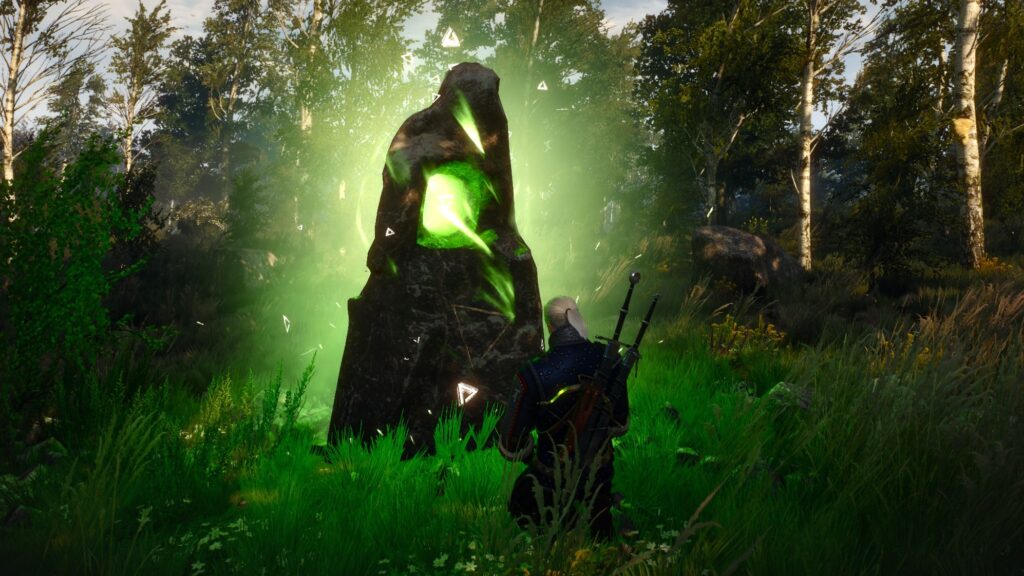
Places of Power are scattered throughout the Witcher 3 world and provide you with one skill point and a temporary buff for a specific magic sign. They’re very useful in the early game because any extra skill points can really help you survive.
The game doesn’t tell you where to find the places of power, but we do. You can check our Place Of Power Locations guide to see them all.
Best early-game weapons
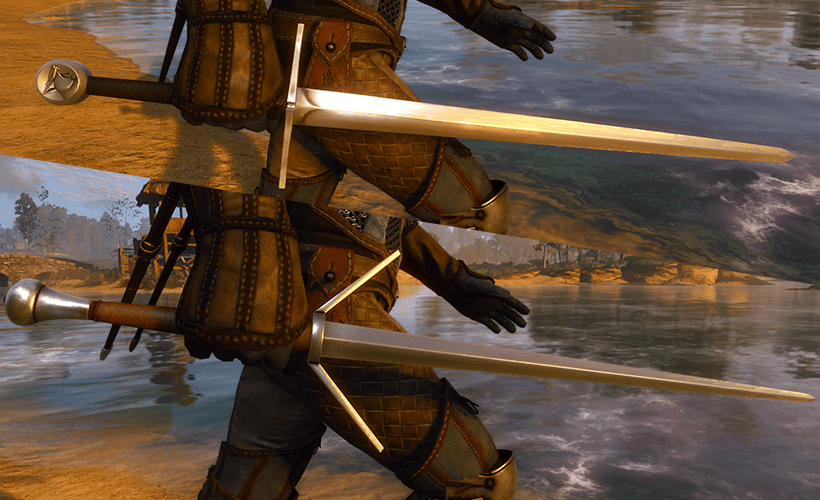
The best early-game weapons in Witcher 3 are the Viper Steel and the Viper Silver swords. These are craftable items, meaning you must find the diagrams and gather the required materials. Both diagrams are found around White Orchard, the game’s starting area:
- The Viper steel sword diagram is in the Amavet Fortress Ruins. The place is located west of the Ransacked village signpost.
- The viper silver sword diagram is in the White Orchard cemetery, north of the Mill signpost. The blueprint will be located inside the building.
Once you have the diagrams, you must gather the required materials. Most of these can be looted from enemies, purchased from merchants, or discovered in chests. Finally, head to the Nilfgaardian Garrison and chat with the blacksmith to craft the swords.
Check out our detailed guide to getting the early-game Viper swords for more tips and details, including how to obtain all the materials.
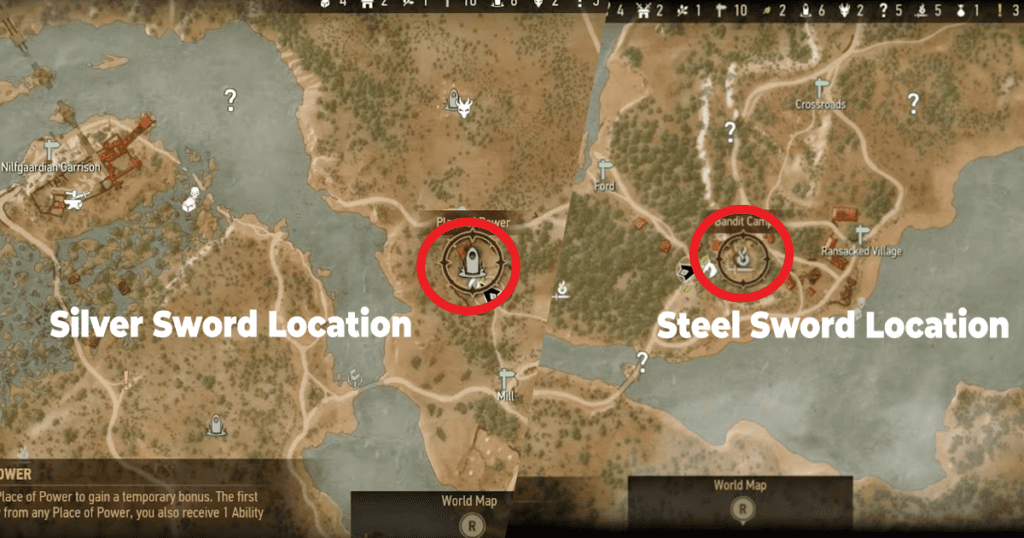
Pro tip: The next-gen update added two relic Witcher swords (steel & silver) to the Novigrad armorer in Hierarch Square (the “top notch swords” guy). These swords have decent stats and match your level when you buy them. The cool thing is that you can level up, sell the swords, meditate, and buy them back at your new level. As far as we know, there’s no limit to how often you can do this. Thanks to kb_92 from reddit for this tip.
Griffin Swords (11+)
From level 11, you have several choices. Generally speaking, the best option is the craftable Griffin steel and silver swords. Not only do they have the highest damage at that level, but they can also be paired with the equally powerful Griffin armor.
Here’s how to get the Griffin sword diagrams:
- The Griffin steel sword diagram can be looted from a skeleton at Hindhold, a ruined watchtower located northwest of Stonecutters’ Settlement.
- The Griffin silver sword’s diagram is found in Lornruk, an abandoned tower on the coast, at the border of Velen and Novigrad.
Once you get the diagrams and the required materials, you can craft the swords at any journeyman (or above) blacksmith, like the one in Oxenfurt or Novigrad.
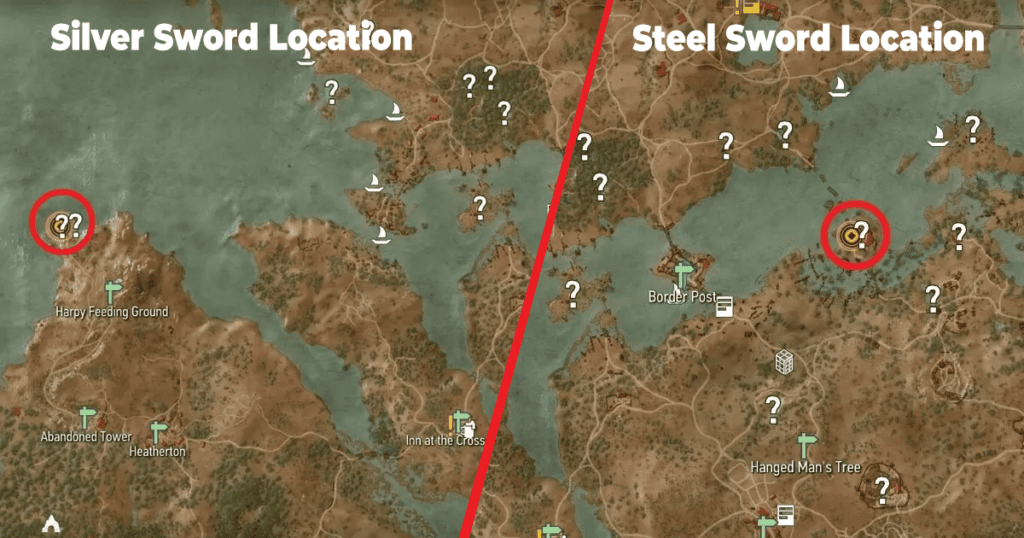
Another option is the Nine-Tailed Vixen steel and silver swords, which were added in Witcher 3’s next-gen update (as long as you have the game’s complete edition). These level 11 swords have lower damage but have better stats for a melee damage build, so you might prefer to use them. They can be found in a chest in Yennefer’s room in the Vizima palace.
Best early game armor
The best Witcher 3 armor set in the early game is the level 4 Temerian armor. It consists of an entire set of light armor, a horse blinder, saddle, and saddlebags.
The set can be bought in White Orchard from the merchant Bram after saving him from the imminent griffin. Here are the best options once you level up.
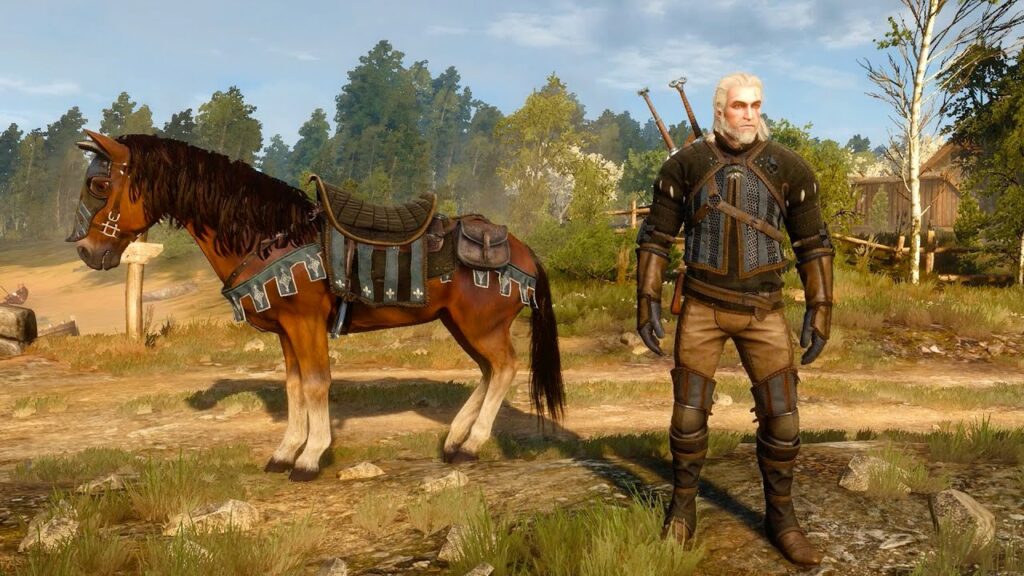
Pro-tip: It’s ideal to match the type of armor you want to wear with your build. Most importantly, you’ll want to match your chosen Witcher school technique (cat/griffin/bear) general skill with the appropriate armor type.
Dol Blathanna Armor (medium, lvl 7)

Next up at level 7 is the medium armor Dol Blathanna set, added in the next-gen update (if you have the Witcher 3 complete edition). You can find it in a chest in Yennefer’s room in the Vizima palace.
Nilfgaardian Armor set (medium, lvl 10)
Once you hit level 10, you can pick up the Nilfgaardian armor set, composed of medium armor pieces and horse equipment. You can buy it from the quartermaster in Crow’s Perch.
Griffin School Armor (medium, lvl 11)
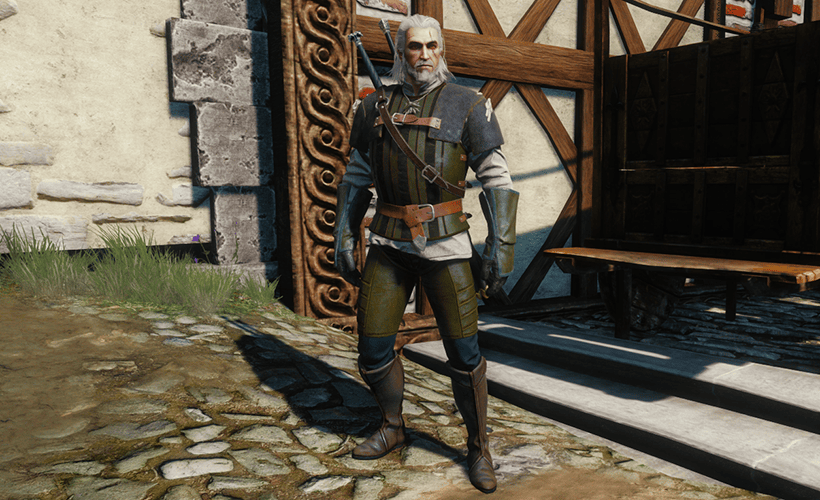
Once you hit level 11, the best option is the crafted Witcher Griffin armor set, which comes with the two swords we mentioned earlier. Although it’s best for sign-oriented builds, it’s still great for everyone. Here’s where to find the diagrams:
- Every Griffin Armor diagram is close to George’s Tomb in the Dragonslayer’s Grotto. The nearest fast travel is in Downwarren. Check our complete guide to finding all the Griffin gear diagrams for a detailed walkthrough.
Wolf School Armor (medium, lvl 14)
Once you hit 14, you can pick up the medium Wolven school gear set. It’s a well-rounded set with a bit of everything. Here’s how to find the diagrams:
- You can buy a map to start the Scavenger Hunt from the blacksmith in Lindenvale. Or you can skip this and fast travel to Kaer Morhen and go to the Old Signal Tower. You’ll find a chest in the ruins with a note that will start the quest. Here’s a detailed guide.
Saddlebags
Saddlebags for Roach increase the maximum weight you can carry. They’re incredibly useful in the early game when you don’t have much carry capacity. For the early game, you have two options:
- The Temerian saddlebags increase max weight by 30 and cost 183 gold pieces from the merchant Bram in White Orchard.
- The Nilfgaardian saddlebags increase max weight by 70 and cost 320 gold pieces from the quartermaster at Crow’s Perch.
Best early-game skills
Although you should choose your skills based on your build, certain skills are so good that they’re pretty much mandatory. Here are the skills we believe are best for the early game portion of Witcher 3:
- School techniques: These bonuses are extremely good for only one skill point. Choose one that fits with your preferred playstyle (Cat for fast attacks/Bear for slow attacks/Griffin for signs) and pair it with the appropriate armor type (light/medium/heavy).
- Strong back: Increases your max weight by 60. Effectively doubling your weight limit in the early game is a great way to save time and stock up on loot.
- Axii delusion: As we mentioned earlier, this skill is awesome for unlocking fresh dialogue options, enhancing immersion, giving extra experience, and sometimes avoiding needless conflicts and paying money.
- Quen active shield: With this skill, Quen will not only negate damage but also heal you. It’s one of the best skills to have in the early game, especially on Death March difficulty (even after it was nerfed in the next-gen update).
- Sun and stars: increased vitality and stamina regeneration are both great in the early game, especially on Death March.
Pro-tip: Keep in mind you can always rotate skills in and out, meaning you can drop those you don’t need at certain points in the game to free up ability slots.
Best early-game builds
Best Overall
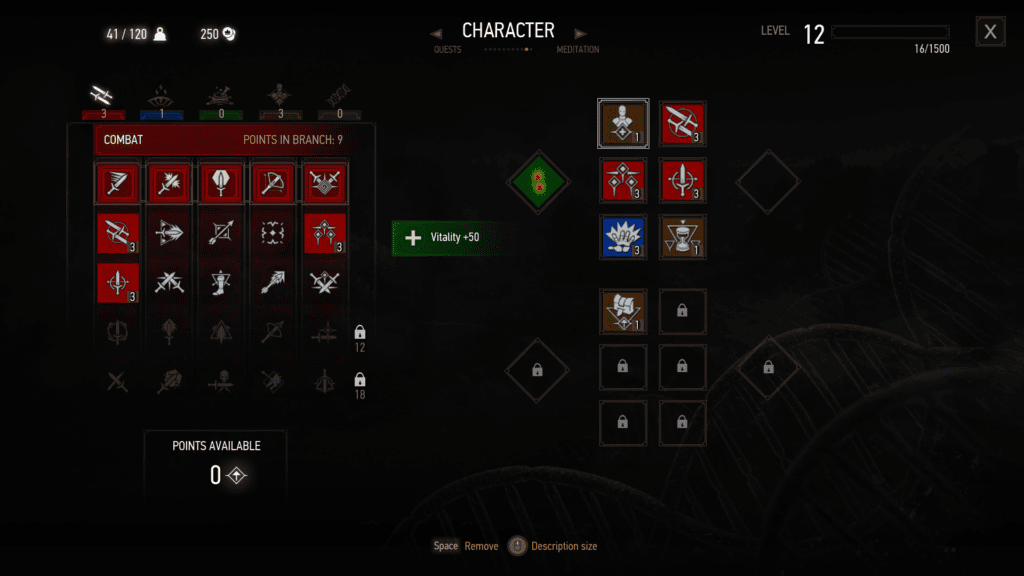
- General: Strong back | Sun and Stars | Cat School Techniques
- Combat: Muscle Memory 3/3 | Resolve 3/3 | Precise Blows 3/3
- Signs: Delusion 2/3 or 3/3
Struggling to choose a Witcher 3 build for the early game? The easiest option is to select your preferred source of damage — fast attacks, strong attacks, or signs — and pair it up with the appropriate school technique.
Generally speaking, the optimal choice is to go for fast attacks and pair them up with Cat school techniques and light armor. Fast attacks provide the highest damage, make it easier to dodge, and are less clunky than signs, especially in the early game.
That’s why for this early-game build, we’ll allocate most points into the fast attack branch of the combat tree.
As for the skill order, we recommend picking up strong back, sun and stars, and at least 2 points in delusion (which is enough for early game dialogue).
When you reach level 4 and pick up the Temerian armor, you can unlock Cat school techniques (since it requires you to wear light armor). Then, you can follow up with the combat skills to boost your damage and flesh out the build.
Boom, there’s your early game starter build. As you progress, this early-game setup can smoothly transition into one of the comprehensive builds discussed in our best Witcher 3 builds guide.
Pro-tip: If you prefer heavy armor and strong attacks, simply go for Bear instead of Cat school techniques and level strong attack skills instead of fast ones.
Best Early-Game Signs Build
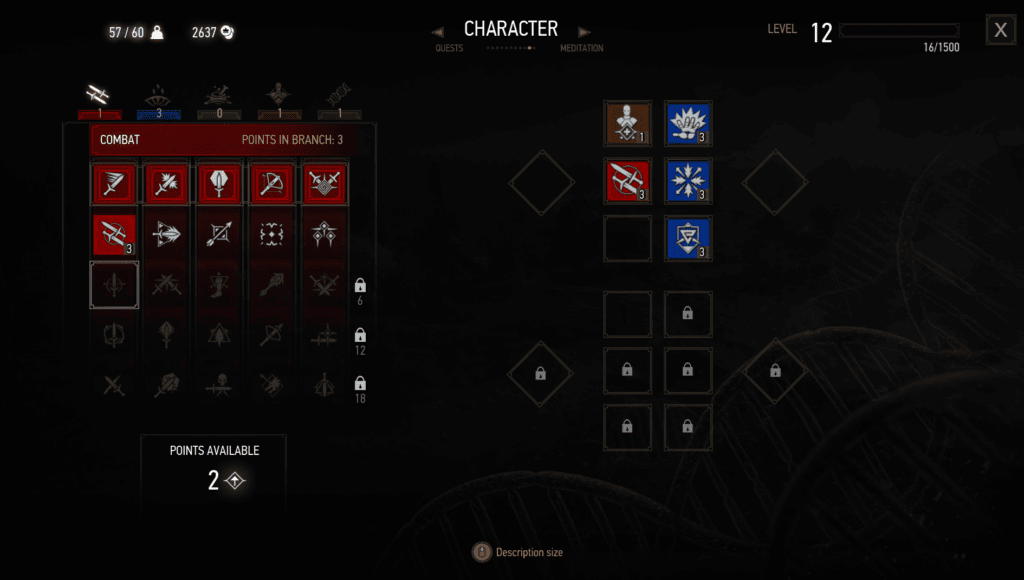
- Signs: Delusion 2/3 or 3/3 | Exploding Shield 3/3/ | Active Shield 3/3
- General: Sun and Stars | Griffin School Techniques | Rage Management
- Combat: Muscle Memory 3/3
Sign builds are relatively weak in the early game because they require mutations to truly shine. But if you really want to go for a signs build anyway, you can go with this setup.
You’ll still have to use your swords if you go signs because you simply won’t do enough damage otherwise. That’s why were picking up rage management to help you cast signs more often by building adrenaline from sword attacks. That’s also why we’re getting muscle memory to boost fast attack damage.
Later on, you can transition this into an all-around signs build (leveling most signs skills) or tailor it towards either Aard or Igni, the two best offensive signs.

Gleb has been playing PC games since the late 1990s and has always enjoyed RPGs the most (Dragon Age, Mass Effect, Elder Scrolls, WoW, Dark Souls, etc.). He had tons of fun playing Witcher 3, so he made this website for discussion, guides, and other info related to the Witcher game, books, and cinematic universe. He travels the world as a digital nomad and spends his time working on website projects, practicing kickboxing, and telling people how awesome intermittent fasting is.
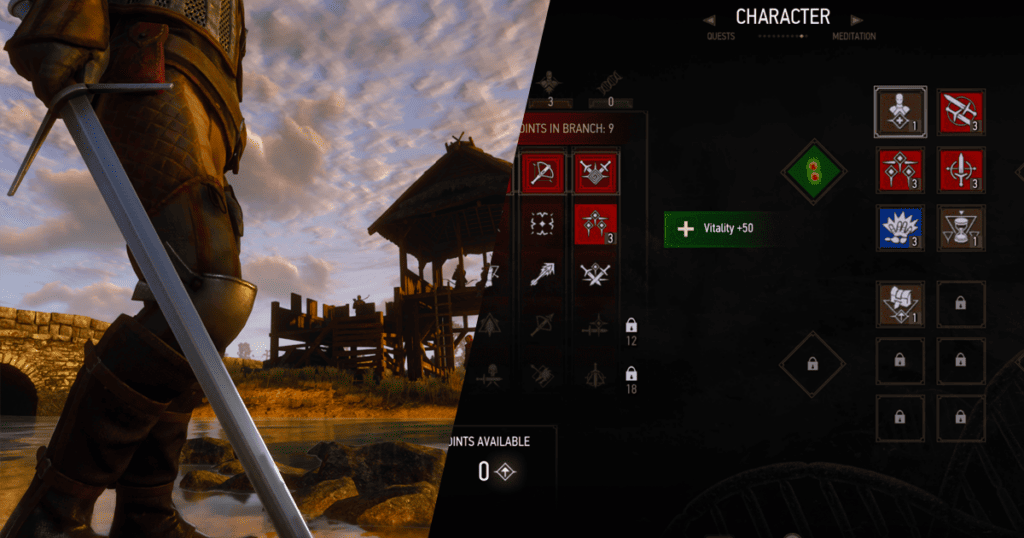
Great guide thank you
Thanks, glad to help 🙂